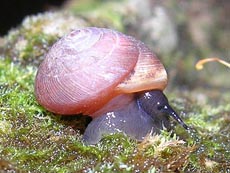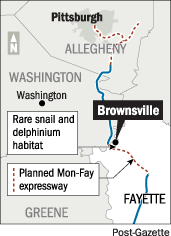
http://www.post-gazette.com/pg/06267/724538-85.stm
Pittsburgh Post Gazette
24 September 2006
By Don Hopey, Pittsburgh Post-Gazette
After hiking along a power line right-of-way, a deer path through the woods and an old jeep trail along Simpson Hill ridge, Tim Pearce scrambles over a honeycombed limestone outcrop and is up to his elbows in leaf litter before you can say escargot.
He's on the hunt for the cherrystone drop snail and the Maryland glyph.

He is also very, very close to the planned route that the Mon-Fayette Expressway will some day take between Brownsville and Uniontown, 19 miles to the south.
The two snail species would be listed as rare or maybe even endangered in Pennsylvania if the state had any classifications at all for these mobile-home members of the mollusk family.
Because the plotted route of the highway has avoided residential areas and runs through what, for now, remain green spaces on the map of southwestern Pennsylvania, rare plants and wildlife may become the project's first road kill.

Whether they and their remote habitat will be safe or a mere bump in the road is unclear for now. But what is certain is that there are a lot of rare things out there and that many get run over because no one's looking.
"The threat," said Mr. Pearce, who is assistant curator and head of the mollusk section at Carnegie Museum of Natural History, "is that they want to build a bridge over Dunlap Creek here, and in the winter the salt will blow or drain into this limestone area. And every kid knows what happens when you put salt on snails or slugs. They shrivel up and eventually dry up."
Also at risk is a rare, wild delphinium -- Delphinium exaltatum -- also known as tall larkspur, which is listed as endangered in Pennsylvania.
Mr. Pearce identified several of those during the hike along the jeep trail, but now has assumed the classic field position for snail collecting: his butt up in the air and his nose in the ground, resting on his elbows in the loamy soil between wild ginger root and the spindly trunks of young cucumber magnolia trees. The hillside is prime habitat for snail species -- including the cherrystone drop -- that are calciphiles, meaning they like the calcium provided by the weathering limestone.
After a few seconds he plucks a snail shell much smaller than his little fingernail out of the forest duff and calls out, "Gastrocopta armifera." In the next few minutes he finds several more species and soon a rare Hendersonia occulta, the cherrystone drop snail.
Katherine Turner, a museum volunteer who has accompanied Mr. Pearce on this snail search, has moved into a similar position slightly down the slope and closer to Dunlap Creek, and she too is well on her way to filling the bottom few inches of a one-quart plastic freezer bag with snail shells, the largest as big around as a quarter, the smallest as small as the period at the end of this sentence.
"Found a big one," Ms. Turner calls out.
"Will it fit in your bag?" Mr. Pearce asks straight-faced.
"Yes," she replies, "but you missed one here."
That's funny because even a cursory sifting of the soil reveals hundreds of snail shells, like sea shells on a very good collectors beach. Suddenly, it seems that snails, normally hidden and private, are everywhere.
Sad story for diversity
Original plans for the expressway identified four potential routes for the stretch just south of Brownsville, but the two preferred alternatives both went through the rare plant habitat on this high, narrow peninsula of land formed by a meander of Dunlap Creek.
Steve Grund, a botanist at the Western Pennsylvania Conservancy who worked to identify any globally rare plant species that might be affected by the project, said the commission later moved the road alignment so it wouldn't go directly over Simpson Hill where the Dunlap Creek bridge footprint wouldn't fall directly on the snails.
"But they weren't able to get the road out of the area completely and now we have real concerns about the indirect impacts, like the introduction of invasive species caused by the construction disturbances, and salt spray from the highway and bridge," Mr. Grund said.
"My job is to look after the plants but I'm more fearful of what will happen to the snails. The delphinium are mainly near the top of the bluff, but the snails are all over the hillside and more likely to get hit by and hurt by the salt. Really it's an unknown."
Tom Fox, a commission spokesman, said the entire 17-mile project was "cleared environmentally" by the Federal Highway Commission in 2000. He said construction on Phase 1, a nine-mile stretch north from Uniontown, Fayette County, is under way.
Construction on Phase 2, the eight-mile section south from Brownsville over Simpson Hill, depends on funding, which depends on a state Transportation Committee report due out in November. It's in final design and has been approved to acquire right-of-way. No construction contracts have been awarded, and the commission has not received the state stream encroachment permit it needs before it can build the bridge over Dunlap Creek.
Mr. Grund said he submitted a proposal to the Turnpike Commission in December asking for funding to set up study plots on Simpson Hill to monitor populations of delphinium and other rare plants, snail populations and the salt levels in the soil, but the commission has not responded.
That proposal, which targets the delphinium population, is still under consideration, according to Dave Willis, the commission's environmental manager. He said the snail colony was identified only within the past year and was not considered or addressed by the project's federal environmental impact study.
One problem is that no state agency has regulatory jurisdiction over terrestrial invertebrates, a group that includes the snails.
"That's a very sad story for diversity," said Chris Firestone, DCNR's wild plant program manager, noting that the state Fish and Boat Commission manages aquatic invertebrates but not those on land. "Other states might have agencies that have jurisdiction, but overall it's an area that's totally overlooked."
Betsy Mallison, a state Department of Environmental Protection spokeswoman, said any permit will likely contain conditions protective of the plant and snail species.
"My guess is there are more rare species at the site. And if we didn't have Tim around we wouldn't even know about the snails," Mr. Grund said.
Out of sight, out of mind
Snails are not animals that are normally sighted or spark interest in Pennsylvania's woods. Mostly out of sight despite being part of the second largest phylum or grouping of animals, behind only insects, they are almost totally out of mind.
Which partly explains why the study of snail ecology in Pennsylvania is, if not in its infancy, still taking baby steps. So unstudied are the state's snails that a map of their distribution lists more species in Allegheny County and Philadelphia County just because more museum researchers are based in those two cities.
Mr. Pearce, whose book, "Mollusks: A Guide to Their Study, Collection and Preservation," co-authored with Charles Surm, was published this summer, is working under a two year, $29,000 grant from the state's Wild Resources Conservation Fund to update Pennsylvania's snail distribution map.
So far he's mapped locations of 150 species of land snails and 60 fresh water snail species. As recently as 1985 only 99 snail species were known to inhabit Pennsylvania.
Aside from a single Maryland glyph found by Smithsonian malacologists -- mollusk specialists -- in 1948 in Allegheny County, no others had been found in the state until one was uncovered during a day-long scientific field collection day called a "Bioblitz," in 2005 in Twin Hills Park, Mt. Lebanon. Since then glyphs have been found on the Simpson Hill site and at a location in Greene County.
The cherrystone drop, known to inhabit 11 states but considered scarce in all of them, was found to inhabit just two Pennsylvania counties last year but now has been spotted in six.
"That's not going to diminish its rareness status, because they're tied to undisturbed limestone areas," said Mr. Pearce, who is heading the effort to evaluate rare and endangered snails for the Pennsylvania Biological Survey. "We don't know if they're actually becoming rarer because we don't have prior baseline data but I suspect they are because of quarrying and habitat destruction."
Mr. Pearce said his and Ms. Turner's collections on Simpson Hill netted 33 different snail species, more than any other site he's surveyed in the state. He termed the diversity "incredible and exciting."
But given snails' below-the-leaf-litter status, Mr. Pearce knows that many people may ask "Who cares?" There are at least three reasons, he said.
"First they are a recycler of forest nutrients, a digester of leaves," he said. "Snails are also being used for drug development to produce painkillers."
And snails are also food for species people do care about, including many species of birds, rats, chipmunks and beetles, a family that includes firefly larvae.
"Without snails," Mr. Pearce said, "most fireflies are gone."
Unlike the snails, people might notice that.
--------------------------------------------------------------------------------
(Don Hopey can be reached at dhopey@post-gazette.com or
412-263-1983. )